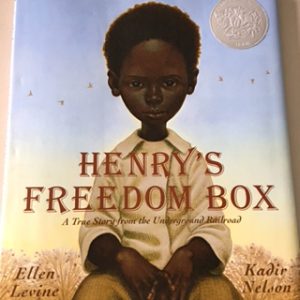Title: Henry’s Freedom Box
Author: Ellen Levine
Illustrator: Kadir Nelson
Publisher & Year: Scholastic Press, 2007
Number of pages: 36
Genre: Historical fiction
The story begins with a young Henry Brown, introduced as a slave living and working with his family. After his master’s death, Henry is sold to another owner who enforces violent punishment in the work room. Henry meets and marries another slave, Nancy, and has three children – but he lives in fear that they will soon be sold and separated from him. His worst fear comes true: his three children and wife are all sold to other owners and Henry immediately begins devising a plan to escape. With the help of a few friends, he ships himself in a wooden crate to Pennsylvania, where he may live as a free man. Upon his arrival, he is given the nickname Henry “Box” Brown.
The text offers a window into a realistic depiction of life in slavery: the pain of a family being divided, the fear of harsh working conditions and vicious enslavers, and the hope for a free life. The ideology behind the story is well-presented in its context. The author does not gloss over the horrific nature of slavery in America’s history and clearly establishes people of power (the slave masters) abusing those under their control (the slaves). Social identities throughout the novel are most transformed through the protagonist, who goes from living with a dream for freedom to achieving a life outside of slavery.
The illustrations ranging from the first page, a portrait of a young boy with no joy on his face, to last, adult Henry climbing out of the wooden box into a room of people welcoming him to freedom, depict this transformation of social identity. Henry goes from only identifying himself as enslaved to realizing that he has successfully escaped the tortures of his master; however, the last page also hints, by Henry’s subtle smile, that he still understands the difficulties and discrimination he will continue to face in a country plagued by slavery practices. In terms of picture book code, for the most part, Henry is depicted on the right page, a position of uncertainty or of movement. This is especially relevant as Henry continues to fight against slavery, escaping his master, and his eventual journey to assisting others to follow suit. The colors used in the illustrations are warm, mostly dark, and some are illuminated by a backlight from a natural source. These positions and lighting choices all help to place the reader within the story, as opposed to merely observing the actions from a distance.
The author’s note at the end of the book is especially important to read to students. It describes more detail about the Underground Railroad and Henry Brown’s assistance with the movement. It also provides factual details and statistics concerning the enslavement of humans in the United States in the mid-1800’s.


